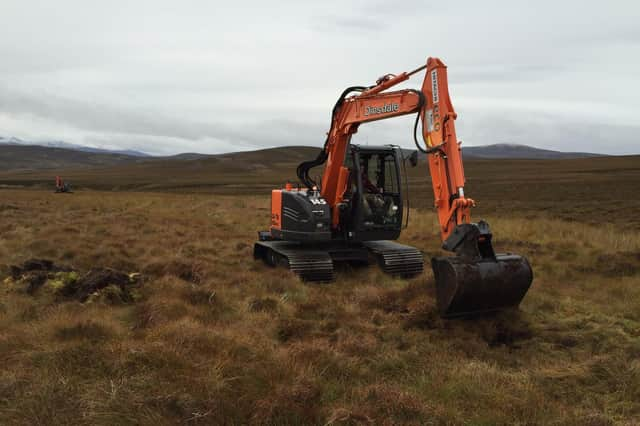Climate change: SNP's land reform plans could wreck its drive to reach net-zero carbon emissions by 2045 – Drew McFarlane-Slack


Big isn’t always better – but when it comes to Scotland’s peatlands, achieving restoration on a large scale is one of the best means to tackle climate change. Scotland’s peat soils cover more than 20 per cent of the country and store around 1.6 billion tonnes of carbon.
However, it is estimated that over 80 per cent of our peatlands are degraded. Peatlands have been subject to artificial drainage, particularly the Second World War as land was sought to produce more food, but other causes of damage include tree planting and extraction of peat for horticultural and energy purposes.
Advertisement
Hide AdAdvertisement
Hide AdPeatlands in good condition actively form peat, removing carbon dioxide from the atmosphere and storing carbon in the soil. Conversely, degraded peatlands may emit more CO2 than they remove and become a net source of greenhouse gases. If we lost all of the carbon stored in our peat soils into the atmosphere, it would be the equivalent of more than 120 times our annual greenhouse gas emissions.
In 2020, the Scottish Government announced a £250 million, ten-year funding package to support peatland restoration, with a target of restoring 250,000 hectares of degraded peatland by 2030. For that ambition to become reality, it requires farmers, landowners and land managers to play a huge role in pushing forward progress on the ground, obtaining funding and then working with specialist contractors – and that’s where scale can be such an advantage.
The Monadhliath Deer Management Group is a collection of estates stretching across a huge expanse of land, from Inverness in the north to Spean Bridge in the south, covering 175,733 hectares in total. Whilst the group was primarily set up to manage deer impacts, it is well placed to deal with a range of complex issues – including peatland restoration.
Working with Peatland Action, the Monadhliath group is now in its third round of peatland restoration projects and, in total, approximately 5,000 hectares of peatland has been restored – accounting for around 11 per cent of the Scottish restoration total so far. That remarkable achievement has been possible by working at a large scale. Fourteen estates have been involved in this project stretching across remote, high-altitude sites that often experience severe winter weather.
By being able to work with large landholdings covering a significant expanse, it has made the process significantly easier. Rather a situation where agreement was required from 50 to 100 individual owners to proceed, a situation which might make collaboration unmanageable, instead landscape-scale restoration has been able to move forward because it has been easier to agree a common purpose.
At every stage of the project, there are benefits. Rather than entering 50 applications for funding, there are 14. Rather than each estate employing its own contractor, there have been five working across the whole region. That not only benefits their knowledge and understanding of the area they’re working on, but also makes the process far cheaper, as a peatland contractor can base themselves in an area for a long-term period rather than hopping between sites around the country and the inevitable expense that comes with that.
Practical work is mostly focused on drain blocking, allowing peatlands to retain water, but much of this effort requires heavy machinery to be taken to isolated and difficult-to-access locations. Again, by working at scale, scheduling of work has been made far easier for contractors, allowing them to make progress more quickly than would have been achievable if tackled in a piecemeal fashion.
This collaboration at scale will also be of benefit to the Scottish Government in meeting the targets it has set on peatland restoration and net-zero by 2045. Yet, in other areas, the government is considering policies which may hinder these objectives.
Advertisement
Hide AdAdvertisement
Hide AdIts latest land reform consultation, ahead of legislation expected next year, makes clear that it wants to tackle concentration of ownership and introduce new regulations around large-scale ownership. For many campaigners, these will be measures that come with few downsides.
Yet, the reality is that many of the Scottish Government’s policies are best served through scale. That includes peatland restoration but can also include deer management and forestry.
The acquisition of the 16,500-acre Glenprosen Estate in Angus in recent weeks by Forestry and Land Scotland – a Scottish Government agency – demonstrates the government’s own need for scale when pursuing environmental projects. Similarly, the purchase of a second tranche of 5,000 acres of Langholm Moor from Buccleuch by the Langholm Initiative, a community body, was said to be vital to create suitable habitats on a large-scale in the expanded Tarras Valley Nature Reserve.
No one can deny the romance of owning your own ‘wee bit hill and glen’, but we do need to acknowledge that government taking a negative view of scale will make it more difficult to tackle climate change at a landscape level when the clock is ticking rapidly down to 2045. Scale of ownership can be very good for our environment – and that can be public, private or community ownership.
The Scottish Government can be pleased by what it has achieved in restoring peatlands thus far, helped in no small part by the willingness of large-scale estates to become involved. It should continue this pursuit in the years and decades to come – but it needs to ensure it doesn’t wreck its own worthwhile ambitions on climate change by seeking short-sighted reforms on land ownership.
Drew McFarlane-Slack is chairman of Monadhliath Deer Management Group
Comments
Want to join the conversation? Please or to comment on this article.